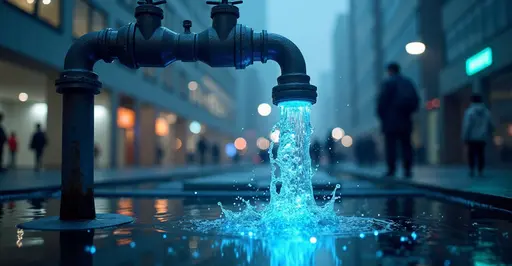
Revolutionizing Municipal Water Management with AI Technology
Municipalities across the globe are embracing artificial intelligence-powered water leak detection systems in a major push to combat water loss and prevent costly pipe bursts. These smart sensor networks represent the cutting edge of urban infrastructure technology, combining IoT sensors, machine learning algorithms, and real-time data analytics to transform how cities manage their water distribution networks.
The Scale of the Water Loss Problem
According to recent studies published in npj Clean Water, the global volume of non-revenue water (NRW) reaches a staggering 126 billion cubic meters annually, costing municipalities approximately $39 billion each year. This represents a massive financial drain on water utilities worldwide, with some regions experiencing NRW rates as high as 64 liters per capita per day.
The implementation of AI-powered detection systems comes at a critical time when climate change and aging infrastructure are putting unprecedented pressure on water systems. Traditional leak detection methods, which often rely on manual inspections and basic SCADA systems, simply cannot keep pace with the scale of modern urban water challenges.
How AI Detection Systems Work
These advanced systems deploy networks of IoT sensors throughout water distribution networks that continuously monitor pressure, flow rates, and acoustic signals. The sensors transmit data via wireless communication technologies like LoRa, NB-IoT, and 5G networks to centralized cloud platforms where machine learning algorithms analyze the information in real-time.
The AI systems can detect anomalies that indicate potential leaks long before they become visible or cause significant damage. By analyzing patterns in water pressure variations, flow irregularities, and acoustic signatures, these systems can pinpoint the exact location of leaks with remarkable accuracy.
Case Studies: Success Stories from Around the World
Singapore's Smart Water Grid: The Public Utilities Board (PUB) of Singapore has emerged as a global leader in smart water management, deploying over 50,000 IoT sensors across its water infrastructure. The system has helped Singapore achieve one of the lowest NRW rates globally at just 4.1%, down from 9% in 2010. Their AI-powered detection system can identify and respond to leaks in under six hours.
Chinese Municipal Initiatives: Cities like Shenzhen, Hangzhou, and Beijing have implemented comprehensive smart water systems. Shenzhen has equipped over 80% of residential households with smart meters, reducing NRW to approximately 6.2%. Beijing has developed sophisticated digital twin models for flood risk assessment and emergency response planning.
European Implementations: In El Prat de Llobregat, Spain, AI systems developed by Adasa Sistemas have successfully detected micro-leaks that were previously undetectable using conventional methods. These systems use advanced acoustic sensors that can identify the unique sound signatures of different types of leaks.
Technical Architecture of Modern Systems
The most advanced AI water management systems operate on a five-layer architecture:
- Data Sensing Layer: IoT sensors and smart meters collect real-time data on water quality, pressure, and flow rates
- Data Transmission Layer: Wireless technologies (5G, LoRa, NB-IoT) transmit data to processing centers
- Data Processing Layer: Cloud platforms and edge computing devices process and integrate heterogeneous data
- Intelligent Analysis Layer: Machine learning algorithms and digital twins perform predictive modeling and anomaly detection
- Decision Support Layer: GIS dashboards and mobile apps enable real-time decision-making and public engagement
Economic and Environmental Benefits
The implementation of these systems delivers significant economic benefits. For every 115 million cubic meters of NRW reduced daily, the annual financial benefit reaches approximately $13 billion. The investment required to achieve this reduction would be around $69 billion with a payback time of 7-10 years.
Environmentally, these systems help conserve precious water resources and reduce the energy consumption associated with water treatment and distribution. They also minimize the environmental damage caused by water main breaks and subsequent repair operations.
Challenges and Future Directions
Despite the clear benefits, several challenges remain. High initial investment costs, data interoperability issues, and cybersecurity concerns represent significant barriers to widespread adoption. Many utilities also face shortages of skilled professionals with the interdisciplinary knowledge needed to implement and maintain these complex systems.
Future developments are likely to focus on enhancing the explainability of AI decisions (XAI), improving edge computing capabilities, and developing more sophisticated digital twin models that can simulate entire water systems under various climate scenarios.
As cities continue to grow and climate change intensifies water scarcity issues, AI-powered water management systems will become increasingly essential for sustainable urban development. The integration of these technologies represents not just an operational improvement but a fundamental shift toward more resilient, efficient, and sustainable water governance.

 Nederlands
Nederlands
 English
English
 French
French
 Deutsch
Deutsch
 Espaniol
Espaniol
 Portugese
Portugese



